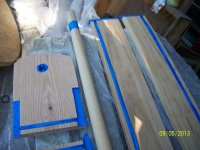Backstory - I'm a DIY guy that Festool has turned into a much better DIY guy. My wife and I have started doing remodels around the house and my latest project is the master bath. Cabinets were built with prefinished Baltic Birch and the face frames are red Oak that of been assembled using pocket screws and glue. The face frames were sealed using general finishes pre-stain conditioner (2 hours rest) and then stained with Minwax oil-based stain to desired color. Finish coat is a water-based oil modified poly. Because this project is been indoors, I've had used to wipe on approach for all of it and I've had to go about four coats to get where I want to be.
In finishing this one (and 88 inch tall vanity), I sanded to a finish that looked good but made a fatal error in that two of the joints were not sanded enough to remove the glue residue. The conditioner didn't show me my mistake but now that I've gotten to the stain I can see two large glue joints where it appears there's almost no stain it all because the glue sealed.

So here's the question-I could resend the entire thing so that I can refinish the entire thing but that seems excessive. My gut tells me I can do a localize sand and then go back and do a localized stain in but I'm wondering if I'm going to end up having problems at the edges were there already is stain and end up with edges in darkness.. I'm not trying to cut corners, but with the number of cabinets that are already being installed another day is another day.
Any advice is appreciated.
Matt
In finishing this one (and 88 inch tall vanity), I sanded to a finish that looked good but made a fatal error in that two of the joints were not sanded enough to remove the glue residue. The conditioner didn't show me my mistake but now that I've gotten to the stain I can see two large glue joints where it appears there's almost no stain it all because the glue sealed.

So here's the question-I could resend the entire thing so that I can refinish the entire thing but that seems excessive. My gut tells me I can do a localize sand and then go back and do a localized stain in but I'm wondering if I'm going to end up having problems at the edges were there already is stain and end up with edges in darkness.. I'm not trying to cut corners, but with the number of cabinets that are already being installed another day is another day.
Any advice is appreciated.
Matt







